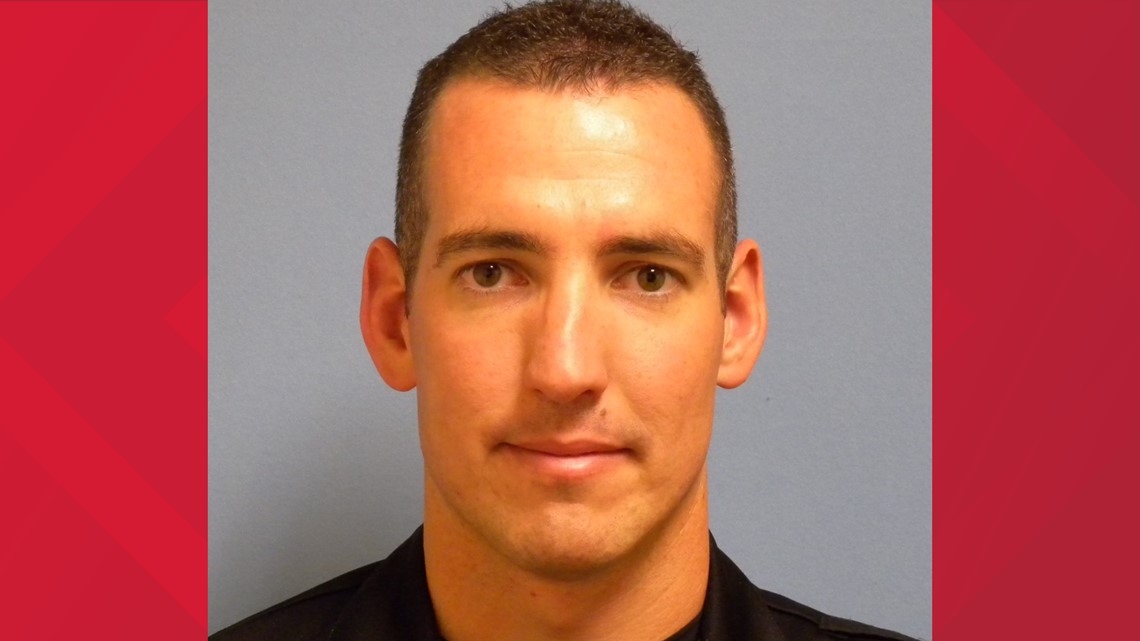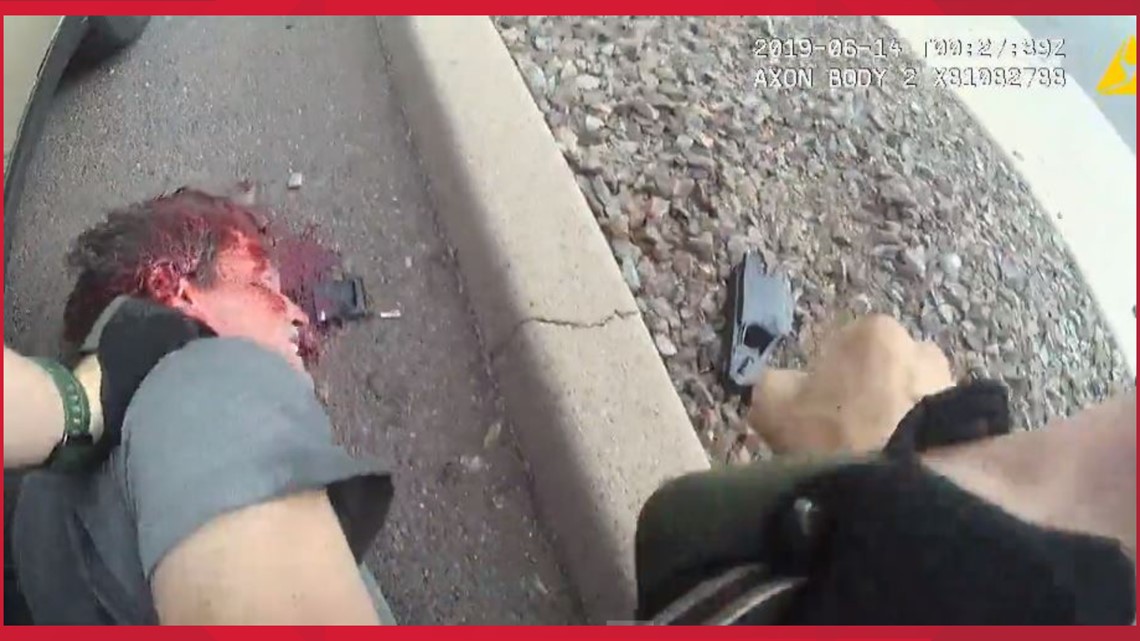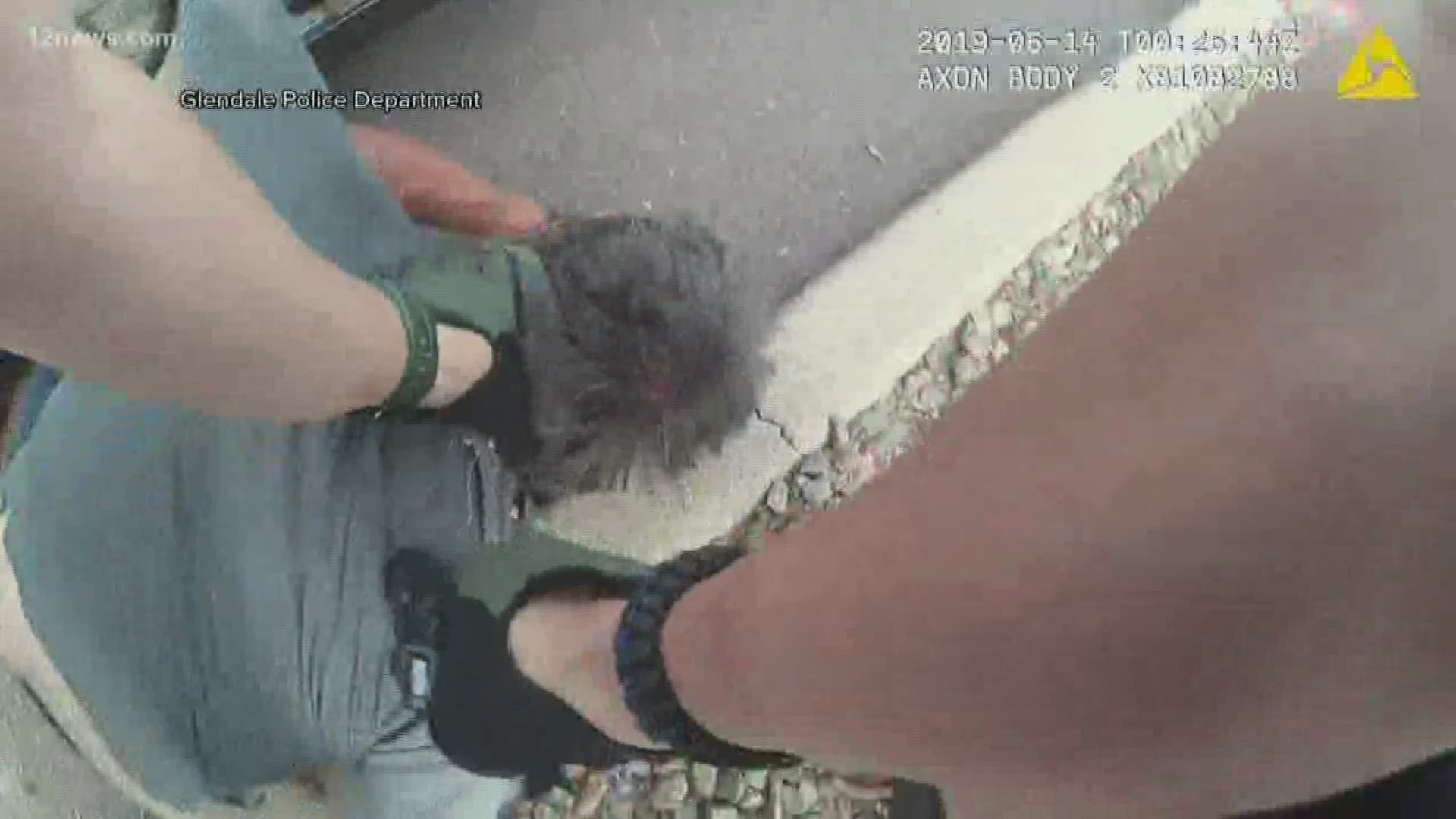GLENDALE, Ariz. — Warning: The videos and photos in this story may be difficult for some to view.
A Glendale police officer resigned last week after the department found that he violated policy after body camera video showed him violently assaulting a man with a Taser.
Joshua Carroll resigned effective Aug. 31 as the city was preparing to serve him with a notice of intent to terminate.
The department found that Carroll had violated policy after he was seen on body-camera video repeatedly using a Taser on David Dulaney, striking Dulaney on the back of the head with his Taser and forcing Dulaney's face and body into the hot pavement, even after he started to bleed.


Dulaney had to undergo a CT scan and received staples for the injury on the back of his head.
Carroll did not have any significant injuries.
Disturbing video shows Dulaney crying before Carroll pulls out Taser
Video released Wednesday by the Glendale Police Department showed Carroll approaching Dulaney as he sat in a car at an apartment complex in the area of 43rd and Peoria avenues on June 13.
The approximately 17-minute video showed Carroll talking to Dulaney, who explained that he fell asleep in his car while he was waiting for his friend to come home.
Dulaney said he had his windows up because he was "scared" of people. Dulaney had also told Carroll that he had a handicap but did not elaborate.
The pair talked for about two minutes before Dulaney asked if he could go see if his friend was home and began saying he was hot and that he didn't want to be in the car anymore.
"I don't mean to cause anybody problems and they don't mean to cause you problems," Dulaney said. "I'm sorry."
Dulaney began to get visibly worried as the conversation continued, saying Carroll was yelling at him "for no reason and I don't know why and I want to call somebody, I want to call somebody please."
Dulaney then asked if he could go and said he had to go to the bathroom really bad. Carroll asked him to step out of the car and Dulaney said he didn't want to because he was scared when Carroll was getting loud with him.
Carroll then said he refused to let Dulaney go because he believed he was under the influence of drugs or alcohol, which Dulaney adamantly denied.
"I don't take alcohol...you know that, I don't do anything, I don't do drugs, I don't do alcohol, I don't do those things," Dulaney said on video.
"You're not letting me go, I have to go to the bathroom really bad and I don't like to go in my pants," he continued. "I don't like to go in my pants, why are you doing this to me?"
Six minutes into the video, Dulaney is seen pleading through tears to Carroll to let him go and let him go to the bathroom.
Shortly after, Carroll reaches through the window, opens the door and becomes more demanding of Dulaney, who is still crying and pleading to leave.
Dulaney is crying with his keys in his hand and sitting in his driver's seat when Carroll grabs his left arm and uses his Taser on him.
"Don't hurt me! What are you gonna shoot me for!" Dulaney said.
Carroll pulls Dulaney to the ground, all the while keeping the Taser active on him. Carroll can then be seen beating the Taser in the back of Dulaney's head and back. Carroll then continued to use the Taser on Dulaney.
Dulaney had blood covering half of his face and was bleeding from his arms and legs.


Carroll then picks up Dulaney and slams his body down into the rocks.
"Please stop hurting me," Dulaney pleads. "Can somebody please call the police?"
"I am the police!" Carroll responds.
Dulaney is face-down on the ground for about five minutes before another officer responds. Body camera video shows blood staining the sidewalk below him.
The high temperature in Glendale on June 13, 2019, was 103 degrees.
Glendale police chief says he's 'extremely disappointed'
Glendale Police Department policy states that officers should "use only the amount of force or control reasonably necessary to conduct lawful public safety activities and the mission of the department."
"Under no circumstances will the force/control used to be greater than necessary to achieve lawful objectives," the policy continued.
Carroll was removed from "uniformed patrol duties" after the incident, the department said Wednesday.
The department launched an internal investigation and referred the incident to the Use of Force Board, which submitted its findings to the department’s Professional Standards Unit.
After the board's review and the unit's investigation, a recommendation was made to fire Carroll.
Glendale's interim Chief of Police Chris Briggs said in a statement that he was "extremely disappointed" in Carroll's actions, but stressed that his behavior is "not reflective of the excellent work that the more than 400 women and men of our organization do on a daily basis."
"We hold our officers to the highest of standards and, as was the case in this incident, we will take swift and decisive action when conduct is not in line with the expectations of our community," he said.
Carroll has detailed past involving 'poor decision making,' commander says
An Aug. 14 discipline recommendation from Commander R. Bradshaw detailed five past incidents that showed that Carroll cannot "respond appropriately to the situations with which he is faced."
Bradshaw wrote that Carroll "has a pattern of discipline involving poor decision making that has escalated to a point that I no longer have confidence in his ability during routine contacts and stressful situations."
Carroll had violations dating back to 2016, with three in 2018 and the latest in January.
He had received three memos of corrections—one for a series of inaccuracies/misrepresentations on his resume during a department promotional process and one for being at fault in a car crash—a letter of counsel for violating department and city social media policy and a written reprimand for violating department policy during a pursuit.
The January 2019 incident in which Carroll violated policy during a pursuit occurred when he advised a trainee to speed more than 100 mph and not stop for red lights. Carroll also fired at a suspect during that same incident, putting others at risk. That incident led to Carroll being removed from the field training program.
Carroll also did not accept responsibility and provided excuses for his actions.
These "poor decisions," Bradshaw wrote, have put "our department, other officers and our community at risk."

